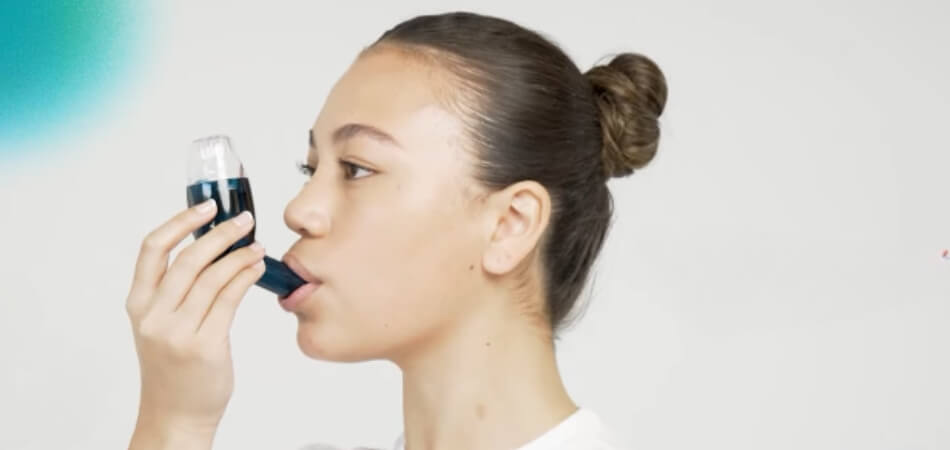Inhalers are a lifeline for individuals living with asthma, providing immediate relief during an asthma attack and helping manage symptoms daily.
These compact devices, filled with medication, can be a bit mysterious in terms of knowing when they're about to run out. It's crucial to have a reliable supply of medication, so you're never caught off guard. The question, “How do I know when my inhaler is empty?” often arises.
A simple method to check is the floating test. By placing the canister in water, you can see if it floats, indicating it has enough medication, or if it sinks, suggesting it's time for a refill.
Here, we’ll dive into more details about managing your inhaler supply effectively. Stay with us as we explore further tips and tricks to ensure you're always prepared.
What is An Inhaler?
An inhaler is a small, handheld device that delivers medication directly to your lungs. It's a game-changer for folks dealing with respiratory conditions like asthma or chronic obstructive pulmonary disease (COPD).

Here's an example:
When you're having trouble breathing, a quick puff from an inhaler can open up your airways in a snap, making it easier to move around.
These gadgets come in various types, but the most common ones allow you to press down on a canister. This releases a measured dose of medication in the form of a fine mist.
You inhale this mist, and voilà, relief knocks. Beyond emergency relief, some inhalers are for daily use to prevent breathing troubles. They're compact, so you can carry them around in your pocket or purse, ensuring you're always prepared, no matter where you are or what you're doing.
The Purpose of Inhalers
Inhalers are like personal assistants for your lungs, especially if you're voyaging life with asthma or chronic obstructive pulmonary disease (COPD).
They're handy, pocket-sized devices designed to deliver medication straight to your lungs, where it's needed most. Let's break down the core purposes of inhalers into two main categories.
Immediate Relief
First off, we have the quick-relief inhalers. These are the ones you reach for when you feel an asthma attack coming on or if you're suddenly short of breath. They work by rapidly opening up your airways, making breathing a lot easier in minutes. Think of them as your emergency go-to.
Long-term Control
Then, there are the controller inhalers. These are the unsung heroes for people with chronic conditions. You use them daily as part of your routine care to keep symptoms at bay and reduce the frequency of flare-ups.
By keeping inflammation in your airways under control, they help you maintain a more normal, active life without constant interruptions from breathing difficulties.
So, whether it's providing immediate relief during an attack or managing symptoms over the long haul, inhalers are crucial tools in the management of respiratory conditions.
Who Uses Inhalers?
Inhalers are the go-to gadgets for a diverse group of people who need a helping hand managing their respiratory conditions. These little devices pack a punch, offering relief and control to those who need it most.
Let’s dive into who exactly finds a friend in inhalers.
Asthma Patients
To start with, asthmatics hold inhalers close to their hearts—literally. Asthma can make the lungs inflamed and narrow, leading to wheezing, coughing, and shortness of breath.
Inhalers for these folks are like keys unlocking a door, providing quick access to easier breathing during flare-ups and helping manage symptoms daily.
COPD Sufferers
Then, we have warriors battling chronic obstructive pulmonary disease (COPD), including chronic bronchitis and emphysema. COPD makes it tough to push air out of the lungs, creating a constant battle for breath.
Inhalers for COPD patients work to reduce symptoms, improve quality of life, and slow the progress of the disease.
Others with Respiratory Issues
Additionally, inhalers also assist people dealing with other respiratory troubles like bronchitis, pneumonia, and even allergic reactions. They ensure that everyone, regardless of their specific condition, has a fighting chance at breathing better and living fuller lives.
Different Types of Inhalers
You may find it challenging to figure out the world of inhalers, as there is quite a variety to choose from, each serving its unique purpose. Whether it's for asthma, COPD, or another respiratory condition, finding the right type of inhaler can make a world of difference in managing symptoms.

Interestingly, devices like the AirPhysio are designed not to deliver medication but to clear mucus from the airways, improving lung capacity through oscillating positive expiratory pressure (OPEP).
Metered Dose Inhalers (MDIs)
MDIs are probably what pops into your head when thinking of an inhaler. They're compact, pressurized canisters that deliver a specific amount of medication as a mist, which you inhale through a mouthpiece. Perfect for on-the-go relief, they require coordination to use effectively.
Dry Powder Inhalers (DPIs)
DPIs ditch the mist for dry powder medication. You activate these by taking a quick, deep breath through the device. They're breath-actuated, meaning they don't need MDI coordination, but they require a strong inhalation.
Soft Mist Inhalers (SMIs)
SMIs are the newer kids on the block, offering a soft mist of medication that's easier to inhale than a traditional MDI. They're especially helpful for those who have difficulty with the fast, deep breaths required by DPIs.
Nebulizers
Nebulizers are effortless. They convert liquid medication into a fine mist you breathe in through a mouthpiece or mask. This is suitable for children or adults who find handheld inhalers tricky. This method takes a bit longer but ensures thorough medication delivery.
How Do I Know When My Inhaler Is Empty?
Have you ever been wheezing and reaching for your inhaler, only to wonder, “How do I know when my inhaler is empty?” It's a common scenario for many.

After all, these devices don't come with a transparent window showing how much medication is left. Knowing when to replace your inhaler is crucial, not just for managing your symptoms effectively but also for ensuring you're never left in a lurch.
Fortunately, there's a simple trick to gauge when it's time for a refill. It involves something as basic as water.
Intrigued? Let's dive deeper into how you estimate your inhaler's lifespan.
The Inhaler Basics
Before we get into the specifics of checking if your inhaler is empty, it's imperative to know that not all inhalers work the same way. The type of inhaler you use might affect how you check its contents. Metered dose inhalers (MDIs), for example, are common types many people wonder about.
The Floating Method
One popular method to check an MDI's status is the floating method. Here's how it works:
Step 1: Preparation
Start by removing the metal canister from its plastic casing. You'll only need a canister for this test.
Step 2: The Test
Fill a bowl with water and gently place the canister in it. Watch how it behaves in the water to get your answer.
Interpreting the Results
Here’s how you can determine the results.
If It Floats
A floating canister usually indicates medication inside. The canister has enough content to stay buoyant. However, this doesn't tell you exactly how much medication is left, just that it's not completely empty.
If It Sinks
A canister that sinks to the bottom is likely empty or nearly so. It's a clear sign that it's time to refill or replace your inhaler.
What are the Limitations and What Should You Consider for Inhalers?
While the floating method can give you a quick indication, it's not foolproof. Accuracy can vary based on the specific inhaler and its design. Plus, it won't tell you the exact amount of medication left.
For a more precise measure, always keep track of your doses. Most inhalers come with a counter that shows the number of doses remaining. If yours doesn't, maintaining a usage log can be a helpful alternative.
You should know when to replace your inhaler, especially in moments of need. While the floating method is a handy trick, relying on the built-in dose counter or keeping a usage log offers a more accurate picture of your inhaler's status.
Staying on top of this not only helps manage your condition more effectively but also ensures peace of mind, knowing you can trust your inhaler to work when you need it most.
FAQs
Sometimes it feels like mastering an art form to guide the world of inhalers. It's not just about taking your medication; it's about how you take it that counts.
To clear the air, let's dive into some frequently asked questions and their answers. This will ensure you get the most out of your inhaler and keep your breathing smooth.
What Can Happen if You Use an Inhaler Wrongly?
If you don't use your inhaler correctly, there's a lot of chance the medicine will end up sticking to your mouth or the back of your throat. This is instead of reaching your lungs where it's needed.
This means your airways won't get the full benefit of the medication, leaving you feeling less relieved than you should be.
What are Common Mistakes When Using an Inhaler?
Common blunders include breathing too forcefully or not forcefully enough, or not taking a deep enough breath when using the inhaler.
Another frequent hiccup is failing to coordinate your breath with the medication release, which can significantly reduce its effectiveness.
How do I Know When My Inhaler is Empty?
A sudden decrease in expected relief can be a sign that your inhaler is running low. Additionally, many inhalers come with dose counters that indicate how many doses are left. If yours lacks a counter, the floating method—a canister that sinks in water and is likely empty—can offer a rough estimate.
Is it Okay to Use My Inhaler after Expiration?
Using an inhaler past its expiration date is not recommended. The medication's potency can decrease over time, meaning it might not provide the relief you need. Always check the expiration date on your inhaler and replace it as necessary to ensure effective treatment.
Wrap Up
We've covered some ground on the ins and outs of inhaler use, highlighting the importance of knowing when to replace this crucial device. Remember, the question “How do I know when my inhaler is empty?” can be answered with simple tricks like the floating method and keeping an eye on the dose counter, if available.
Using your inhaler correctly is just as vital as monitoring its contents to ensure you're getting the medication you need. For those on the move, always carry a spare inhaler and remember the expiration date to avoid being caught off guard.
Keeping these tips in mind will make managing your respiratory condition a breeze, even when traveling.






